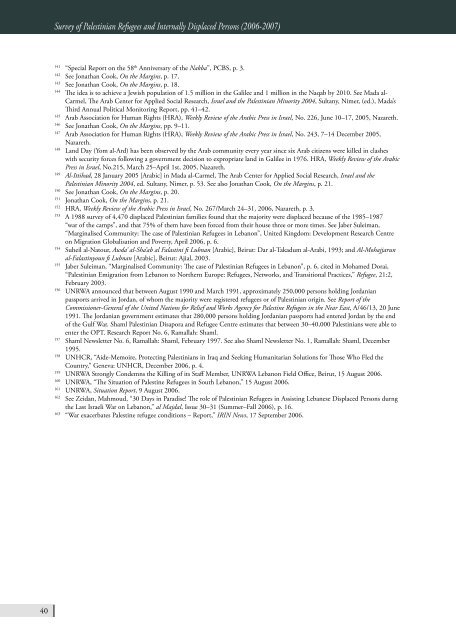BADIL Resource Center for Palestinian Residency and Refugee
BADIL Resource Center for Palestinian Residency and Refugee
BADIL Resource Center for Palestinian Residency and Refugee
Create successful ePaper yourself
Turn your PDF publications into a flip-book with our unique Google optimized e-Paper software.
40<br />
Survey of <strong>Palestinian</strong> <strong>Refugee</strong>s <strong>and</strong> Internally Displaced Persons (2006-2007)<br />
141 th “Special Report on the 58 Anniversary of the Nakba”, PCBS, p. 3.<br />
142 See Jonathan Cook, On the Margins, p. 17.<br />
143 See Jonathan Cook, On the Margins, p. 18.<br />
144 The idea is to achieve a Jewish population of 1.5 million in the Galilee <strong>and</strong> 1 million in the Naqab by 2010. See Mada al-<br />
Carmel, The Arab <strong>Center</strong> <strong>for</strong> Applied Social Research, Israel <strong>and</strong> the <strong>Palestinian</strong> Minority 2004, Sultany, Nimer, (ed.), Mada’s<br />
Third Annual Political Monitoring Report, pp. 41–42.<br />
145 Arab Association <strong>for</strong> Human Rights (HRA), Weekly Review of the Arabic Press in Israel, No. 226, June 10–17, 2005, Nazareth.<br />
146 See Jonathan Cook, On the Margins, pp. 9–11.<br />
147 Arab Association <strong>for</strong> Human Rights (HRA), Weekly Review of the Arabic Press in Israel, No. 243, 7–14 December 2005,<br />
Nazareth.<br />
148 L<strong>and</strong> Day (Yom al-Ard) has been observed by the Arab community every year since six Arab citizens were killed in clashes<br />
with security <strong>for</strong>ces following a government decision to expropriate l<strong>and</strong> in Galilee in 1976. HRA, Weekly Review of the Arabic<br />
Press in Israel, No.215, March 25–April 1st, 2005, Nazareth.<br />
149 Al-Ittihad, 28 January 2005 [Arabic] in Mada al-Carmel, The Arab <strong>Center</strong> <strong>for</strong> Applied Social Research, Israel <strong>and</strong> the<br />
<strong>Palestinian</strong> Minority 2004, ed. Sultany, Nimer, p. 53. See also Jonathan Cook, On the Margins, p. 21.<br />
150 See Jonathan Cook, On the Margins, p. 20.<br />
151 Jonathan Cook, On the Margins, p. 21.<br />
152 HRA, Weekly Review of the Arabic Press in Israel, No. 267/March 24–31, 2006, Nazareth, p. 3.<br />
153 A 1988 survey of 4,470 displaced <strong>Palestinian</strong> families found that the majority were displaced because of the 1985–1987<br />
“war of the camps”, <strong>and</strong> that 75% of them have been <strong>for</strong>ced from their house three or more times. See Jaber Suleiman,<br />
“Marginalised Community: The case of <strong>Palestinian</strong> <strong>Refugee</strong>s in Lebanon”, United Kingdom: Development Research Centre<br />
on Migration Globalisation <strong>and</strong> Poverty, April 2006, p. 6.<br />
154 Suheil al-Natour, Awda’ al-Sha’ab al Falastini fi Lubnan [Arabic], Beirut: Dar al-Takadum al-Arabi, 1993; <strong>and</strong> Al-Mohajjarun<br />
al-Falastinyoun fi Lubnan [Arabic], Beirut: Ajial, 2003.<br />
155 Jaber Suleiman, “Marginalised Community: The case of <strong>Palestinian</strong> <strong>Refugee</strong>s in Lebanon”, p. 6, cited in Mohamed Dorai,<br />
“<strong>Palestinian</strong> Emigration from Lebanon to Northern Europe: <strong>Refugee</strong>s, Networks, <strong>and</strong> Transitional Practices,” <strong>Refugee</strong>, 21:2,<br />
February 2003.<br />
156 UNRWA announced that between August 1990 <strong>and</strong> March 1991, approximately 250,000 persons holding Jordanian<br />
passports arrived in Jordan, of whom the majority were registered refugees or of <strong>Palestinian</strong> origin. See Report of the<br />
Commissioner-General of the United Nations <strong>for</strong> Relief <strong>and</strong> Works Agency <strong>for</strong> Palestine <strong>Refugee</strong>s in the Near East, A/46/13, 20 June<br />
1991. The Jordanian government estimates that 280,000 persons holding Jordanian passports had entered Jordan by the end<br />
of the Gulf War. Shaml <strong>Palestinian</strong> Disapora <strong>and</strong> <strong>Refugee</strong> Centre estimates that between 30–40,000 <strong>Palestinian</strong>s were able to<br />
enter the OPT. Research Report No. 6, Ramallah: Shaml.<br />
157 Shaml Newsletter No. 6, Ramallah: Shaml, February 1997. See also Shaml Newsletter No. 1, Ramallah: Shaml, December<br />
1995.<br />
158 UNHCR, “Aide-Memoire, Protecting <strong>Palestinian</strong>s in Iraq <strong>and</strong> Seeking Humanitarian Solutions <strong>for</strong> Those Who Fled the<br />
Country,” Geneva: UNHCR, December 2006, p. 4.<br />
159 UNRWA Strongly Condemns the Killing of its Staff Member, UNRWA Lebanon Field Office, Beirut, 15 August 2006.<br />
160 UNRWA, “The Situation of Palestine <strong>Refugee</strong>s in South Lebanon,” 15 August 2006.<br />
161 UNRWA, Situation Report, 9 August 2006.<br />
162 See Zeidan, Mahmoud, “30 Days in Paradise! The role of <strong>Palestinian</strong> <strong>Refugee</strong>s in Assisting Lebanese Displaced Persons durng<br />
the Last Israeli War on Lebanon,” al Majdal, Issue 30–31 (Summer–Fall 2006), p. 16.<br />
163 “War exacerbates Palestine refugee conditions – Report,” IRIN News, 17 September 2006.

















